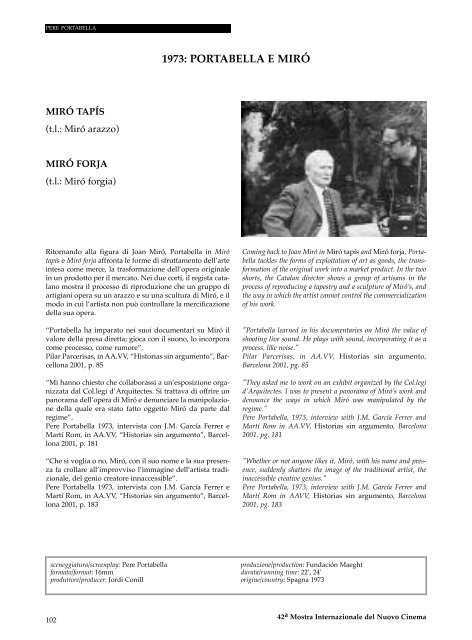Catalogo - Mostra internazionale del nuovo cinema
Catalogo - Mostra internazionale del nuovo cinema
Catalogo - Mostra internazionale del nuovo cinema
Create successful ePaper yourself
Turn your PDF publications into a flip-book with our unique Google optimized e-Paper software.
PERE PORTABELLA<br />
MIRÓ TAPÍS<br />
(t.l.: Miró arazzo)<br />
MIRÓ FORJA<br />
(t.l.: Miró forgia)<br />
Ritornando alla figura di Joan Miró, Portabella in Miró<br />
tapís e Miró forja affronta le forme di sfruttamento <strong>del</strong>l’arte<br />
intesa come merce, la trasformazione <strong>del</strong>l’opera originale<br />
in un prodotto per il mercato. Nei due corti, il regista catalano<br />
mostra il processo di riproduzione che un gruppo di<br />
artigiani opera su un arazzo e su una scultura di Miró, e il<br />
modo in cui l’artista non può controllare la mercificazione<br />
<strong>del</strong>la sua opera.<br />
“Portabella ha imparato nei suoi documentari su Miró il<br />
valore <strong>del</strong>la presa diretta; gioca con il suono, lo incorpora<br />
come processo, come rumore”.<br />
Pilar Parcerisas, in AA.VV, “Historias sin argumento”, Barcellona<br />
2001, p. 85<br />
“Mi hanno chiesto che collaborassi a un’esposizione organizzata<br />
dal Col.legi d’Arquitectes. Si trattava di offrire un<br />
panorama <strong>del</strong>l’opera di Miró e denunciare la manipolazione<br />
<strong>del</strong>la quale era stato fatto oggetto Miró da parte dal<br />
regime”.<br />
Pere Portabella 1973, intervista con J.M. García Ferrer e<br />
Martí Rom, in AA.VV, “Historias sin argumento”, Barcellona<br />
2001, p. 181<br />
“Che si voglia o no, Miró, con il suo nome e la sua presenza<br />
fa crollare all’improvviso l’immagine <strong>del</strong>l’artista tradizionale,<br />
<strong>del</strong> genio creatore innaccessible”.<br />
Pere Portabella 1973, intervista con J.M. García Ferrer e<br />
Martí Rom, in AA.VV, “Historias sin argumento”, Barcellona<br />
2001, p. 183<br />
sceneggiatura/screenplay: Pere Portabella<br />
formato/format: 16mm<br />
produttore/producer: Jordi Conill<br />
102<br />
1973: PORTABELLA E MIRÓ<br />
Coming back to Joan Miró in Miró tapís and Miró forja, Portabella<br />
tackles the forms of exploitation of art as goods, the transformation<br />
of the original work into a market product. In the two<br />
shorts, the Catalan director shows a group of artisans in the<br />
process of reproducing a tapestry and a sculpture of Miró’s, and<br />
the way in which the artist cannot control the commercialization<br />
of his work.<br />
"Portabella learned in his documentaries on Miró the value of<br />
shooting live sound. He plays with sound, incorporating it as a<br />
process, like noise."<br />
Pilar Parcerisas, in AA.VV, Historias sin argumento,<br />
Barcelona 2001, pg. 85<br />
"They asked me to work on an exhibit organized by the Col.legi<br />
d’Arquitectes. I was to present a panorama of Miró’s work and<br />
denounce the ways in which Miró was manipulated by the<br />
regime."<br />
Pere Portabella, 1973, interview with J.M. García Ferrer and<br />
Martí Rom in AA.VV, Historias sin argumento, Barcelona<br />
2001, pg. 181<br />
"Whether or not anyone likes it, Miró, with his name and presence,<br />
suddenly shatters the image of the traditional artist, the<br />
inaccessible creative genius."<br />
Pere Portabella, 1973, interview with J.M. García Ferrer and<br />
Martí Rom in AAVV, Historias sin argumento, Barcelona<br />
2001, pg. 183<br />
produzione/production: Fundación Maeght<br />
durata/running time: 22’, 24'<br />
origine/country: Spagna 1973<br />
42 a <strong>Mostra</strong> Internazionale <strong>del</strong> Nuovo Cinema

















